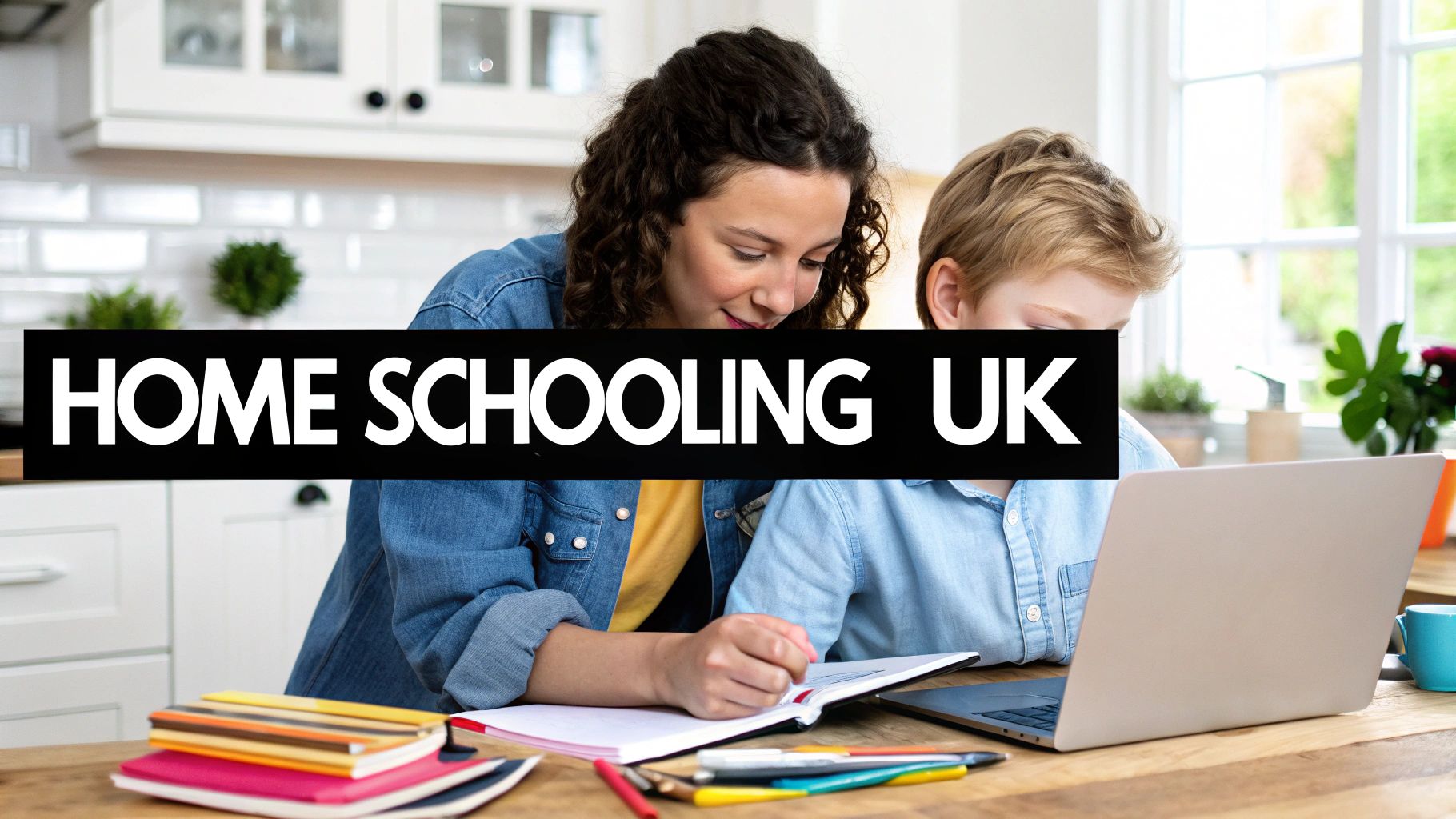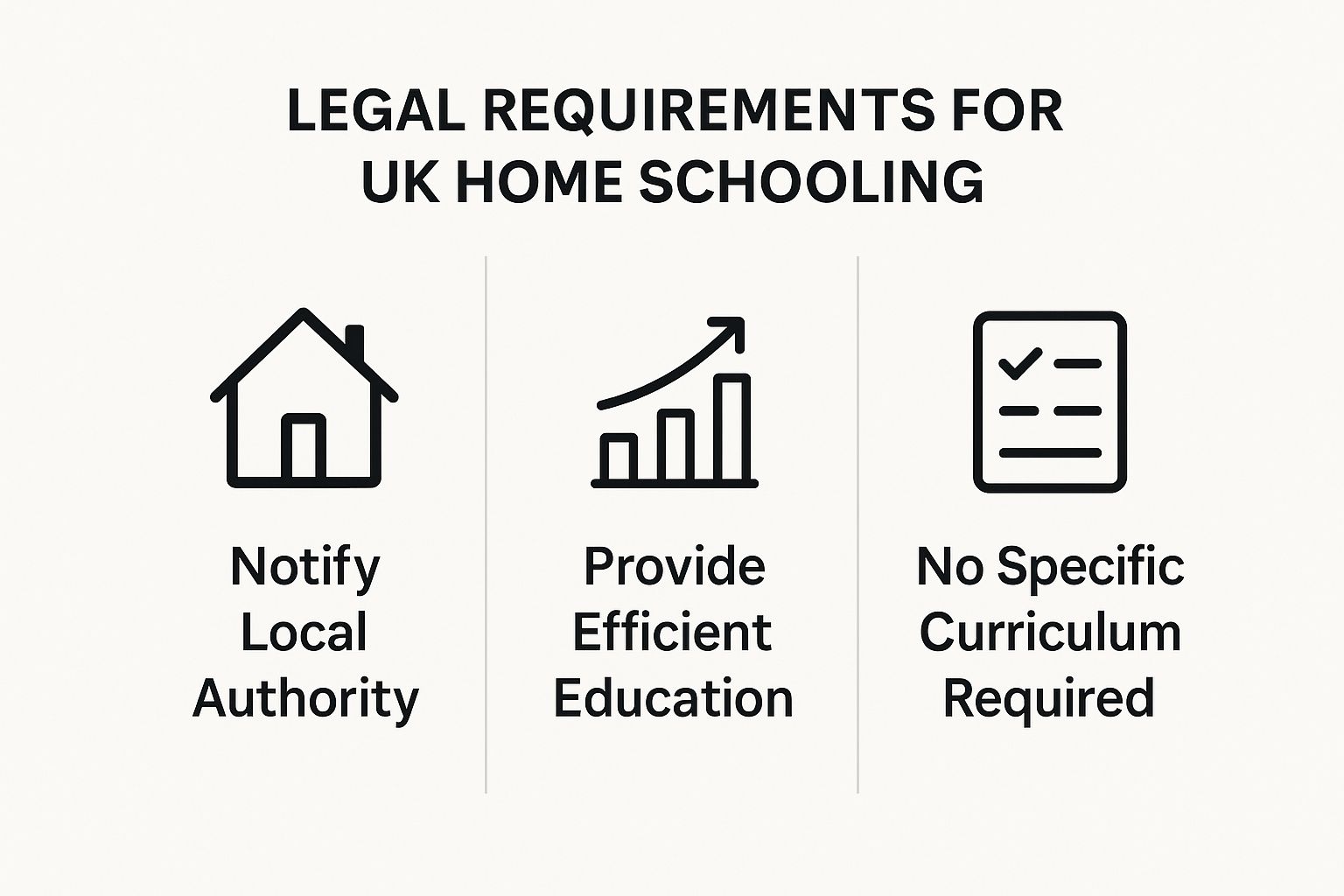Deciding to explore home schooling in the UK is a huge step, one that usually comes from a deep desire to give your child an education that truly fits them. It’s a path more and more families are choosing, driven by the hope of crafting a learning journey that feels flexible, deeply supportive, and built around the unique spark in their child. This guide is here to walk you through it all, with clarity and a bit of heart.
Is Home Schooling the Right Path for Your Family?

Thinking about home education often stirs up a mix of powerful emotions—a thrill of excitement at the possibilities, alongside a quiet flicker of "am I doing the right thing?". You're not alone in feeling this way. For most parents, this isn't about rejecting school, but about intentionally choosing something that feels more aligned with their family's values and, most importantly, their child’s happiness.
The goal isn't to replicate a formal classroom at the kitchen table. It’s about creating an education that breathes with your child’s natural curiosity and pace. It’s about putting their needs, their passions, and their emotional wellbeing right at the very centre of their world.
Why Families Choose Home Education
The reasons for choosing home education are as unique and personal as the children themselves. Sometimes, the traditional school system, despite its best intentions, just isn’t the right environment for a child's specific needs—whether they're academic, social, or emotional.
Just imagine these real-life scenarios:
- A bright, creative child who feels stifled by a rigid curriculum and is starting to lose their natural spark for learning. You see that light in their eyes dimming a little more each day.
- A sensitive child dealing with anxiety or bullying, where the school environment has become a source of daily distress instead of a place to grow.
- A child with special educational needs who you know would absolutely thrive with a one-to-one, tailored approach that a busy classroom simply can't offer.
- A family that wants to travel or follow a different lifestyle, turning education into a flexible adventure where the world is the classroom.
In every one of these cases, choosing home schooling becomes an act of love and empowerment. It’s a way for parents to take back control and create an environment where their child feels safe, seen, and genuinely inspired to learn. The many advantages of this approach are well-known, and you can explore more about the benefit of homeschooling in our detailed article.
Trusting Your Instincts as a Parent
At the end of the day, you are the world's leading expert on your child. The decision to even explore home schooling is often a sign that you see their true potential and are fiercely committed to helping them flourish. It’s about having the courage to ask, "What does my child really need to succeed and, above all, be happy?"
Home education is not just an alternative to school; it is a fundamental shift towards a personalised, child-centred approach to learning and life. It empowers families to build an education that honours their child's individuality.
This journey is about building confidence—in your child, and in yourself. By focusing on their unique strengths and interests, you can nurture a genuine love of learning that will stay with them for a lifetime.
Navigating the Legal Landscape of Home Education
The idea of legal requirements can feel a bit daunting, sparking worries about getting something wrong. But here’s the thing: understanding your responsibilities is the very first step toward feeling confident and in control. Think of it less like a rigid set of rules and more as a simple framework designed to ensure your child gets the education they deserve.
At its heart, the law in the UK is built on a straightforward and empowering principle: your child has a right to a suitable education, and the duty to provide this rests with you, the parent. Whether you choose a mainstream school or opt for home schooling in the UK, you are in the driving seat.
This infographic breaks down the fundamental legal principles that apply across the UK, giving you a clear visual starting point.

The key takeaway is that the system is built on trust and flexibility. It prioritises your child's wellbeing and education over bureaucratic hurdles.
Taking the First Step: Deregistering Your Child
If your child is currently enrolled in a school, your first practical move is to formally withdraw them. This process is known as deregistration, and it’s much simpler than it sounds. For most families in England and Wales, it just involves sending a clear, polite letter to the school’s headteacher.
You don’t need the school’s permission. This letter isn't a request; it's a notification of your decision to take on the full responsibility for your child’s education.
Here's a practical example of what to include in your letter:
- Your Child's Details: Their full name and date of birth.
- A Clear Statement: "I am writing to inform you that I am withdrawing [Child's Name] from school from [Date] to provide elective home education."
- Legal Reference (Optional but helpful): "This is in accordance with Section 7 of the Education Act 1996."
Keep it simple and direct. Once the school receives this, they are legally required to remove your child’s name from the register and inform the local authority. That one action officially kicks off your home education journey.
What Does ‘Suitable Education’ Actually Mean?
The term "suitable education" might sound a bit vague, but that’s entirely intentional. This flexibility gives you the freedom to create a learning experience that is genuinely tailored to your child. It absolutely does not mean you have to follow the national curriculum, stick to school hours, or conduct formal lessons.
A suitable education is one that prepares your child for life in their community and enables them to reach their full potential. It must be appropriate for their age, ability, and aptitude, and any special educational needs they may have.
This means you get to put your child’s unique needs first. For example, if your child is a hands-on learner who struggles to sit still, a ‘suitable education’ might involve building projects, nature walks, and museum visits instead of endless workbook exercises, because that's how they'll truly learn and thrive.
Here are a few practical examples of what this could look like:
- For a 7-year-old who loves stories: Learning history could mean reading myths and legends together, then acting them out with LEGO figures. Maths might involve writing a story about a character who has to solve number puzzles to complete a quest.
- For a 14-year-old passionate about the environment: Science could be a project on local wildlife conservation, involving field trips and data collection. English could involve writing letters to local MPs about environmental policies.
Your approach to providing a quality online home education UK can look worlds apart from a traditional classroom, and that's perfectly okay. In fact, that's often the whole point.
Your Relationship with the Local Authority
Once you deregister, your local authority (LA) will likely get in touch. Their legal duty is to make sure all children in their area are receiving a suitable education. It’s important to know that they are not there to inspect you, judge your choices, or try to catch you out.
Most LAs make "informal enquiries," perhaps asking for a brief report or just having a friendly chat about your educational philosophy and the resources you're using. You are not legally required to agree to home visits or provide specific evidence like timetables or rigid lesson plans.
Remember, you are the educator. This conversation is a chance to share your passion for your child’s learning journey. You can feel confident explaining how your chosen approach meets your child's needs, which helps build a positive and collaborative relationship right from the start.
Home Schooling Legal Requirements Across the UK
While the core principle of providing a "suitable education" is the same everywhere, the specific duties and interactions with local authorities can differ slightly depending on where you live in the UK. Understanding these regional nuances is key to a smooth start.
| Nation | Deregistration Process | Local Authority Contact | Definition of 'Suitable Education' |
|---|---|---|---|
| England | Letter to the school headteacher is sufficient. No permission needed. School informs the LA. | LAs have a duty to identify children not receiving a suitable education. They make "informal enquiries". | Based on age, ability, aptitude, and any special educational needs (SEN). No requirement to follow the National Curriculum. |
| Wales | Letter to the school headteacher. No permission needed. School informs the LA. | LAs are more proactive and will likely contact you to discuss your provision. | Similar to England, tailored to the child's age, ability, and aptitude. The new Curriculum for Wales is not mandatory for home educators but can be a guide. |
| Scotland | You must seek consent from your local council to withdraw your child from a state school. This is usually a formality. | The local council must be satisfied that a suitable education is being provided. Regular contact is common. | Education must be "efficient and suitable". This is generally interpreted in a similar, flexible way to the rest of the UK. |
| Northern Ireland | You must notify the Education Authority (EA) in writing of your intention to home educate. | The EA must be satisfied that the child is receiving a suitable education. They may request information or evidence of your provision. | Defined as a "full-time education suitable to his or her age, ability and aptitude and to any special educational needs he or she may have." |
As you can see, while the spirit of the law is consistent, the administrative side varies. Scotland and Northern Ireland require more formal notification and consent, whereas in England and Wales, a simple letter of withdrawal is enough to begin. Being aware of your nation's specific guidelines will help you navigate the process with confidence.
Designing an Education Your Child Will Love

This is where the real joy of home education begins. Once you’re comfortable with the legal side of things, you get the incredible freedom to design a learning experience built entirely around your child. The goal isn't just to replicate a classroom at the kitchen table; it's about nurturing a genuine, lifelong passion for discovery.
The beauty of home schooling in the UK is this very flexibility. You can step away from the one-size-fits-all model and craft something that truly honours your child's personality, interests, and natural learning rhythm. It’s a creative process that puts their needs and their boundless curiosity right at the heart of their education.
Finding Your Family's Educational Philosophy
Before diving into lesson plans or choosing resources, it can be incredibly helpful to take a step back and think about your core approach. The home education world is full of different philosophies, and finding one that aligns with your family’s values is a brilliant first step.
Think of it like choosing a parenting style – there's no single "right" way, just the way that feels best for you and your child.
-
Structured Learning: This is the most school-like approach, often following a set curriculum with a timetable. For a child who feels anxious with uncertainty, this clear structure can be incredibly calming, providing the comfort of a predictable daily rhythm.
-
Thematic or Project-Based Learning: Here, learning is woven around a central topic your child is excited about. For example, a child obsessed with space could learn physics by building rockets, maths by calculating orbits, and English by writing science fiction stories. It makes learning feel connected, purposeful, and thrilling.
-
Autonomous or Child-Led Learning (Unschooling): This philosophy is built on a deep trust that children are natural learners. When you give them the freedom and resources, they will actively pursue their own interests. Learning happens organically through everyday life—a question about a bug in the garden can lead to a deep dive into entomology.
Many families end up blending elements from different styles, creating a unique hybrid that changes and adapts as their children grow.
Putting Your Child at the Centre
The reasons families choose home education are deeply personal. Research shows that around 23% of families do it for lifestyle or philosophical reasons, while 13% are unhappy with mainstream schools, and another 14% have concerns about their child's mental health.
This tells us something vital: home education is often a direct, loving response to a child’s individual needs.
At its heart, designing a home education is an act of deep listening. It’s about observing your child, understanding what makes them light up, and building their learning journey from that spark of enthusiasm.
This means that if your child adores video games, you don’t have to see it as a distraction. It can become a launchpad for learning. They could learn coding to build their own game (ICT), design characters and worlds (art), write a compelling storyline (English), and collaborate with friends online (social skills). You're meeting them where they are.
From Philosophy to Practice
Turning your big ideas into a daily reality is the next exciting challenge. The key is to build a flexible framework, not a rigid prison of lesson plans. You want enough structure to guide the day but enough freedom for your child to follow a sudden burst of curiosity.
For instance, a family using a project-based approach might see their child get fascinated by castles after a family trip.
- Their learning might include: building a detailed model castle (design technology), researching its history and the lives of its inhabitants (history), writing a diary from the perspective of a knight (English), and even experimenting with catapult physics in the garden (science).
This approach makes learning feel more like an adventure than a chore. To add another layer to this, you could look at how technology can support their projects. A great place to start is by exploring next-gen learning tools like Gizmos Edu Laptops, which can open up new worlds of interactive research and creativity.
Ultimately, designing your child's education is a fluid, ongoing process. Some days will feel structured and productive; others might be spent entirely on a nature walk that sparks a dozen new questions. Both are equally valuable. For more guidance on finding the right materials, you can learn about choosing a homeschool curriculum UK that fits your family's approach. Embracing this flexibility is the secret to nurturing a happy, engaged, and truly curious learner.
Finding Your Family's Home Schooling Rhythm
One of the first questions I always hear from parents dipping their toes into home schooling in the UK is, "But what does a day actually look like?" And the brilliant thing is, there’s no single answer. You get to leave the rigid 8 am to 3 pm school bell behind and design a daily rhythm that feels natural, joyful, and perfectly in sync with your child's unique energy and curiosity.
This isn’t about recreating the classroom with a colour-coded timetable taped to the wall. Forget that. Think of it more as building a flexible framework—a gentle rhythm that offers structure without stress, and predictability without pressure. It’s about weaving learning into the very fabric of your family's life, rather than boxing it into set hours.
Tune Into Your Child’s Natural Flow
The best home education routines are always built around the child, not the clock. A young child’s ability to focus is worlds away from a teenager cramming for exams, and your daily flow needs to respect that. The goal is a sustainable pace that nurtures their love for learning, rather than causing burnout.
A little one, for instance, will thrive on a routine that feels more like guided play than formal lessons. Their day should be a gentle dance between creative messes and quiet moments, respecting their natural energy levels.
A Possible Rhythm for a 6-Year-Old:
- Morning: You could start softly, reading a story together on the sofa. Then, move into some hands-on maths with LEGO bricks or while baking a cake. After that, a trip to the park or a walk in the woods is perfect for burning off some energy and exploring nature.
- Afternoon: After lunch, it might be time for a quiet period with drawing or an audiobook. A short, sharp phonics session of just 15-20 minutes could be followed by a big collaborative project, like building an epic cardboard fort.
This kind of approach respects a young child's need to move, play, and switch things up, making learning feel like an exciting part of life.
Adapting the Rhythm as They Grow
As children get older, their needs change, as does their capacity to concentrate for longer stretches. For a teenager working towards GCSEs, the rhythm will naturally have more structure to make sure they can cover the material in a deep, meaningful way.
But even then, it doesn't have to look like a traditional school day. The freedom of home education means they can work when they're at their best. If your teen is a night owl who struggles in the morning, their most productive study time might be in the late afternoon or evening.
A Possible Rhythm for a 15-Year-Old (GCSE Prep):
- Morning (10 am start): They could kick off with a tricky subject like Maths or Science for a solid 90-minute session, followed by a proper break to recharge.
- Midday: Switch gears to a different kind of thinking with an hour of English literature analysis or history research.
- Afternoon: After a good lunch and some downtime, they might dive into a practical skill like coding, art, or music practice, before circling back to review notes or plan an essay.
This gives them the discipline needed for exams while also empowering them to manage their own time and energy—a crucial life skill that builds confidence and independence.
Your Home is the Classroom
You don't need a dedicated 'school room' with pristine desks to make this work. For most families, learning happens all over the house. The kitchen table seamlessly transforms from a breakfast bar into a science lab for messy experiments, and the living room becomes a cinema for history documentaries.
The secret isn’t having the perfect setup, but cultivating an atmosphere where curiosity is celebrated and resources are easy to grab. A basket of fascinating books in the living room or a well-stocked art supplies drawer can turn any corner into a space for discovery.
When you integrate learning with daily life, children start to see that education isn’t some separate chore—it's part of everything. Household tasks become hands-on lessons in life skills, responsibility, and even applied maths (like budgeting for the weekly shop).
Ultimately, finding your rhythm is a process of trial and error. What works one month might need a tweak the next. The key is to stay tuned in to your child’s needs, creating a healthy balance between structured learning and the freedom to explore. It’s this supportive environment where home-educated children so often flourish. In fact, academic assessments show that home-schooled children frequently outperform their peers in traditional schools, scoring between 15% to 30% higher on standardised tests. You can dig into more of the data behind this trend in these UK homeschooling statistics. This success is often chalked up to the personalised, less stressful learning environment that a family's unique rhythm helps create.
Building a Thriving Social and Support Network

Let's start by tackling the biggest myth about home schooling in the UK: the idea that children learn in isolation, cut off from their friends. Honestly, the reality is often the complete opposite.
Home education can open the door to a richer, more diverse social life than many people imagine—one that isn't confined to a classroom of 30 other kids all born in the same year. It’s about finding your tribe, for both you and your child, and creating a network that offers friendship, support, and shared adventures. For your child, it’s a chance to build genuine connections based on shared interests rather than just a shared postcode.
Finding Your Local Community
Your first port of call is usually right on your doorstep. Across the UK, thriving networks of home-educating families are organising meet-ups, workshops, and activities every single day. The trick is just knowing where to look.
Social media is an excellent starting point. A quick search for "[Your Town/County] Home Education" or "UK Homeschoolers" on Facebook will likely reveal a handful of active groups. These online hubs are where you'll find the real-world connections.
So, what does that look like in practice for your child?
- Weekly Park Meet-Ups: Imagine informal gatherings where children of all ages play together—the older ones helping the younger ones—while you get to have a proper chat with other parents who just get it.
- Group Educational Trips: Organising discounted entry to museums, science centres, or historical sites. It turns a solo trip into a shared learning experience and a brilliant day out with friends.
- Skill-Sharing Co-ops: Parents pooling their talents. One mum might run a weekly art session, another a French lesson, and a dad could start a coding club. Your child gets to learn from passionate adults in a relaxed, fun setting.
These groups provide a lifeline, especially in the early days. They’re a powerful reminder that you are not alone and offer a ready-made community eager to welcome you.
Beyond the Usual Social Circles
One of the most beautiful aspects of home education is the freedom for children to build friendships across a wide range of ages. Your child isn't limited to interacting with only their year group, which fosters incredible emotional intelligence, empathy, and communication skills.
Think about all the different opportunities available for your child to connect:
- Forest Schools: These popular outdoor sessions bring children of different ages together to learn bushcraft, explore nature, and build resilience and friendships around a campfire.
- Specialised Workshops: Many museums, galleries, and theatres run specific daytime workshops for home-educated children, letting them dive deep into subjects like robotics or drama with other passionate learners.
- Sports Teams and Clubs: Your child can join local gymnastics, football, swimming, or martial arts clubs, integrating them fully into the wider community just like any other child and connecting over a shared passion.
Building a social network in home education is about quality over quantity. It's about fostering deep connections with a diverse group of people, which helps children develop the confidence to engage with anyone, anywhere.
This rich tapestry of interactions prepares them for life in a way a single classroom environment sometimes cannot.
In recent years, these support networks have grown significantly. The rise in communities providing social and extracurricular opportunities has been a huge factor in putting those old worries about isolation to bed. This growth helps explain the continuing expansion of home schooling in the UK, and you can discover more insights about these social factors on myedspace.co.uk.
Creating this network empowers your whole family. You’ll find parents who understand your challenges and celebrate your successes, while your child builds a circle of friends based on genuine connection and shared passions.
Finding Affordable Resources for Your Journey
One of the most reassuring truths about home schooling in the UK is that a brilliant, heartfelt education doesn’t need a hefty price tag. For many families, stepping away from school fees, uniform costs, and expensive trips actually brings a sense of financial relief. It’s all about being resourceful and creative, and knowing where to tap into the incredible wealth of low-cost and free materials out there.
Crafting a rich learning experience for your child on a budget is more than achievable. The key is to shift your mindset from buying expensive, all-in-one packages to curating resources that genuinely serve your child's needs and interests.
Leveraging Free and Low-Cost Educational Treasures
Your journey into affordable home education can start with things you probably already have access to. These places are absolutely packed with high-quality content that can easily form the backbone of your child's learning.
Just think about the wealth of knowledge right at your fingertips:
- Your Local Library: This should be your first port of call. It's a magical place. Beyond just borrowing books, libraries offer free access to computers, Wi-Fi, and often run workshops and events that are perfect for home-educated children.
- Free Online Platforms: Websites like BBC Bitesize and Khan Academy are goldmines. They offer comprehensive, curriculum-aligned lessons for all ages, from primary maths to A-Level physics, completely free of charge. Your child can learn at their own pace, re-watching videos until a concept clicks.
- Museums and Galleries: So many of the UK's national museums offer free entry. A day spent exploring the Science Museum or the Natural History Museum can spark more inspiration and understanding than a dozen textbook chapters ever could. It makes learning real and tangible.
These resources alone allow you to provide a varied and engaging education without spending a penny. And when you're looking for content on specific subjects, online guides can be incredibly helpful. For instance, a practical guide to English conversation for beginners can be a great support for language development.
Smart Strategies for Saving Money
As you get further into your home education journey, some costs are simply unavoidable, like exam fees or specialised materials for a hobby your child adores. But there are countless ways to be smart with your spending and make every pound count.
The heart of affordable home education isn't about restriction; it's about resourcefulness. It's seeing the learning potential in everyday life and connecting with a community that believes in sharing.
For example, getting in touch with other local home-educating families opens up a world of cost-saving opportunities. You could organise a book swap or share subscriptions to educational magazines. Many families also buy and sell second-hand curriculum materials through online groups, often getting excellent resources for a fraction of the original price.
Teaming up for a group discount on a workshop or a trip is another fantastic way to provide amazing experiences for your child while keeping costs down for everyone. By tapping into the community, you make your budget stretch so much further while building truly valuable connections along the way.
Got Questions About Home Schooling? Let's Get Them Answered.
Thinking about home schooling in the UK is exciting, but it’s completely natural for a few practical questions to pop up. Feeling clear on the details is a massive part of the journey, freeing you up to focus on what really matters—your child’s happiness and growth. Let's walk through some of the most common queries.
Can My Child Still Take GCSEs and A-Levels?
Yes, absolutely. This is a very well-trodden path for home-educated students, and they often achieve fantastic results. Your child simply sits their exams as a private candidate.
In practice, this means you’ll be responsible for:
- Finding an exam centre that accepts private candidates (plenty of schools and colleges do).
- Covering the exam entry fees yourself.
- Making sure your child has covered the entire syllabus for each subject they’re taking.
Many families find online course providers or specialist tutors an absolute lifesaver during these exam years, providing structure and expert guidance when it's needed most. A bit of forward planning makes navigating the system a perfectly manageable process, leading to the same internationally recognised qualifications your child would get in school.
What Happens if My Child Has Special Educational Needs?
Home education can be a wonderfully positive and supportive environment for a child with Special Educational Needs (SEND). It gives you the freedom to create a truly bespoke learning plan, away from the sensory overload or social pressures that can make a busy classroom so challenging. Every single activity can be tailored to their specific needs, strengths, and pace, allowing them to learn in a way that feels safe and successful.
If your child has an Education, Health and Care Plan (EHCP), the local authority is still legally required to make sure their needs are met. It’s vital you chat with them before you deregister your child from school. This is just to ensure they're happy that the education you’re planning is suitable for your child’s specific requirements. So many parents discover that the calm, focused setting of home education allows their child to flourish in ways they never thought possible.
Is There Any Financial Help for Home Schooling?
As a general rule, there’s no direct government funding for families who choose to home educate in the UK. The financial side of things—resources, activities, and any exam fees—rests with you as the parent.
The core idea is that by choosing to home educate, you're also choosing to take on the full financial cost. You will, of course, still receive any standard benefits you're entitled to, like Child Benefit.
This is exactly why tapping into the huge variety of free and low-cost resources we talked about earlier is so important for making your budget work for you and your family.
What if Home Schooling Doesn’t Work Out for Us?
Education is a journey, not a final destination, and it's more than okay to change your route if you need to. If you find that home education is no longer the right fit for your child or your family, you can simply apply for a school place at any time.
There’s absolutely no sense of failure in adapting to what your child needs. The time you spent learning together at home will have been an incredibly valuable experience, strengthening your bond and giving you unique insights into how your child learns best that will serve them well, whatever path they take next.
At Queens Online School, we understand the deep commitment behind choosing a different educational path. We provide a structured, supportive, and engaging British curriculum online, blending live expert teaching with the flexibility your family needs. Discover how we can support your child's learning journey today.

